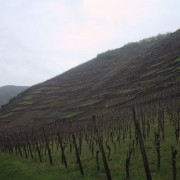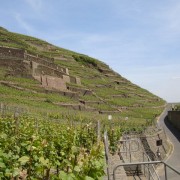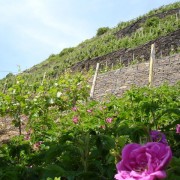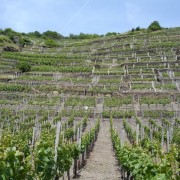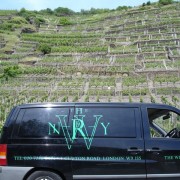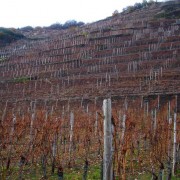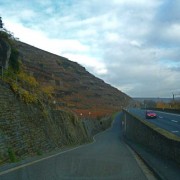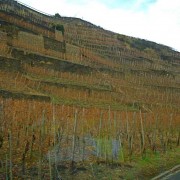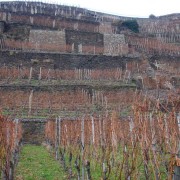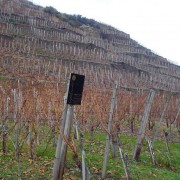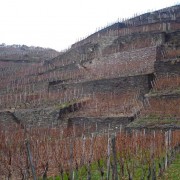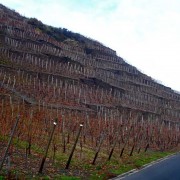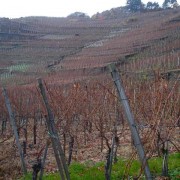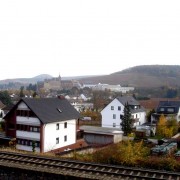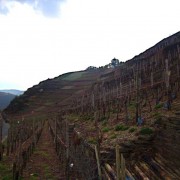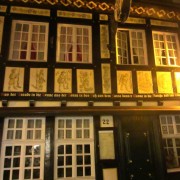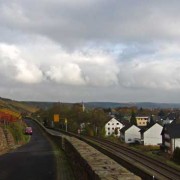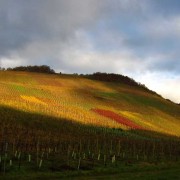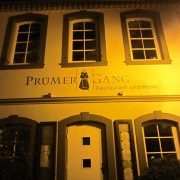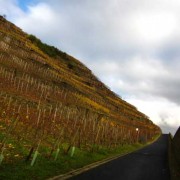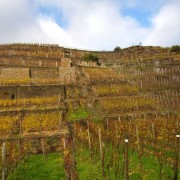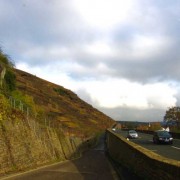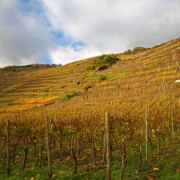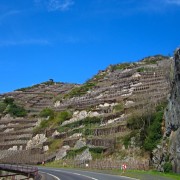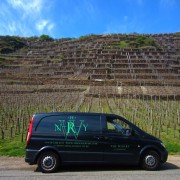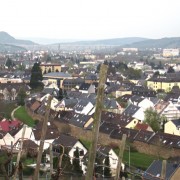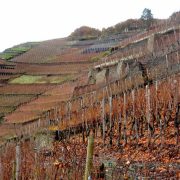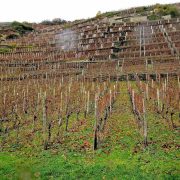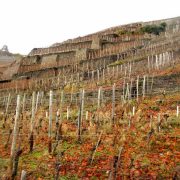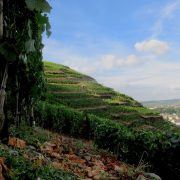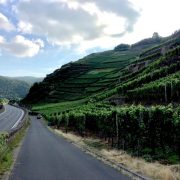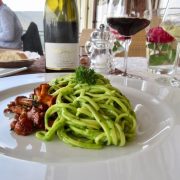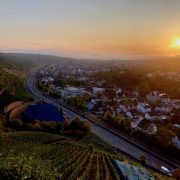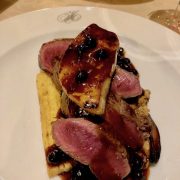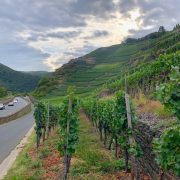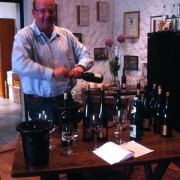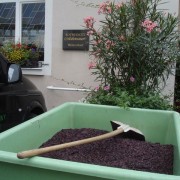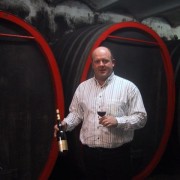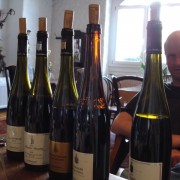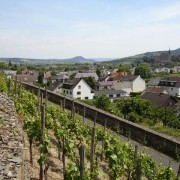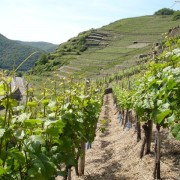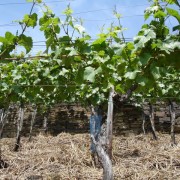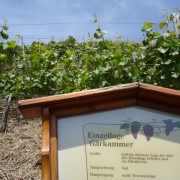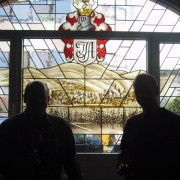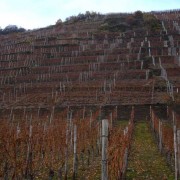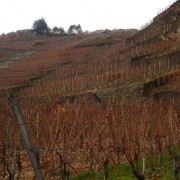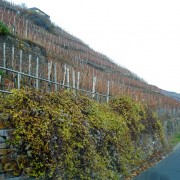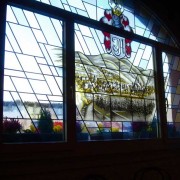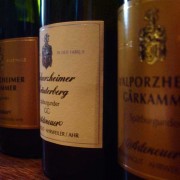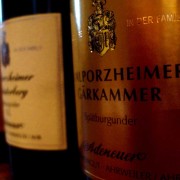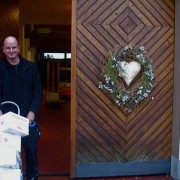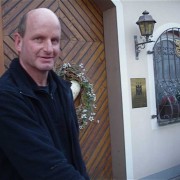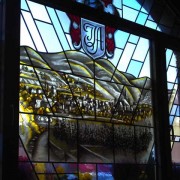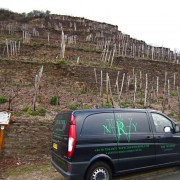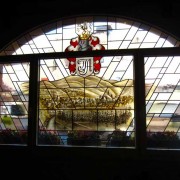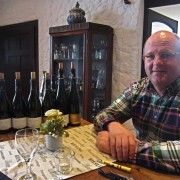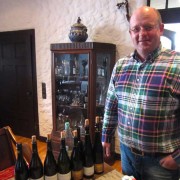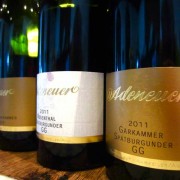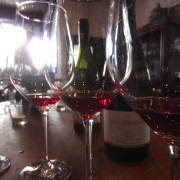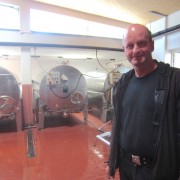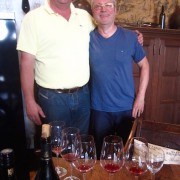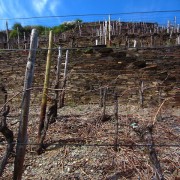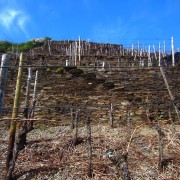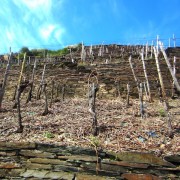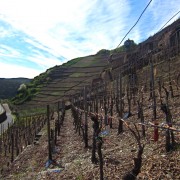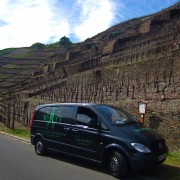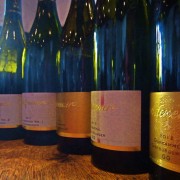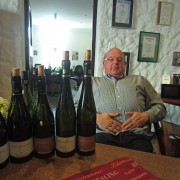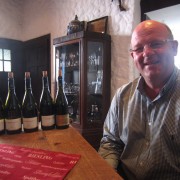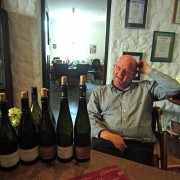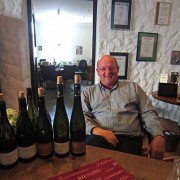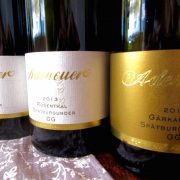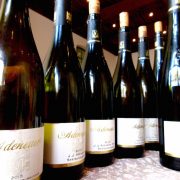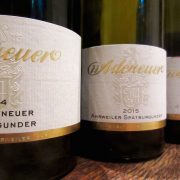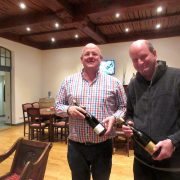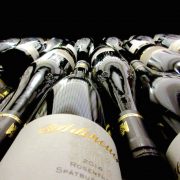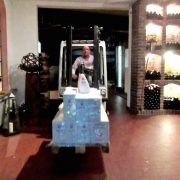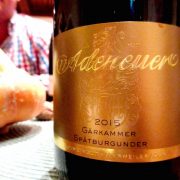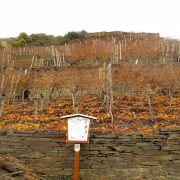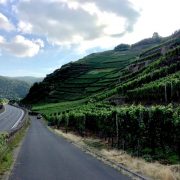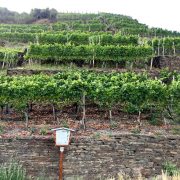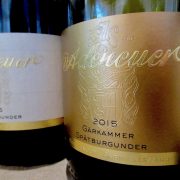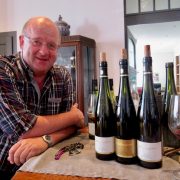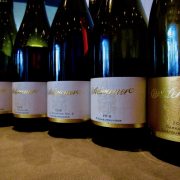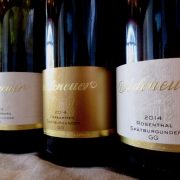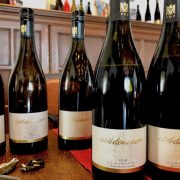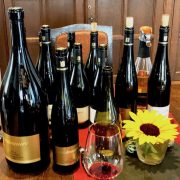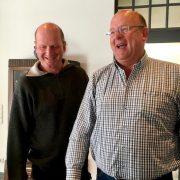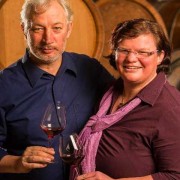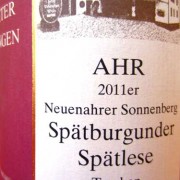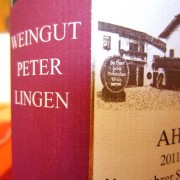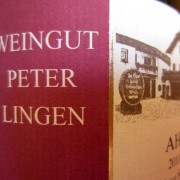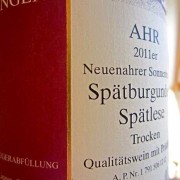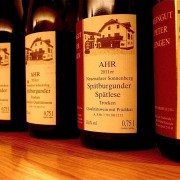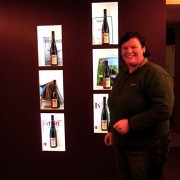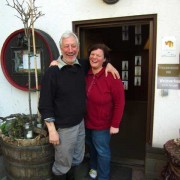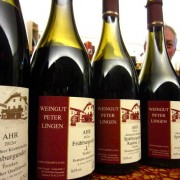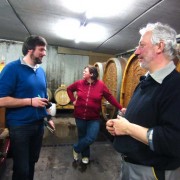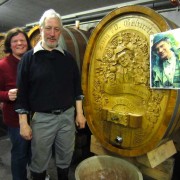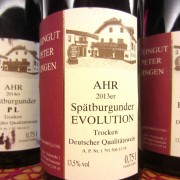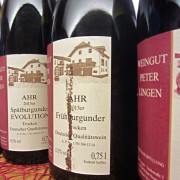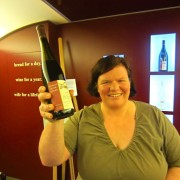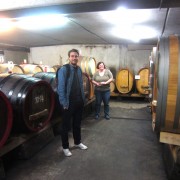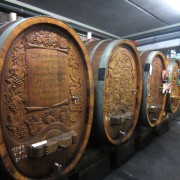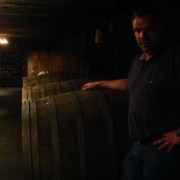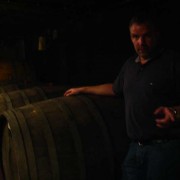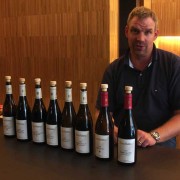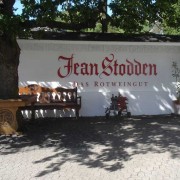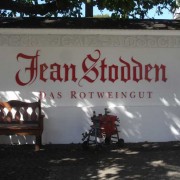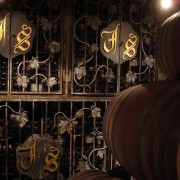The tiny Ahr valley lies in one of the northernmost winemaking regions of Germany, between Cologne and Koblenz. Romans planted vines here. Some say the sheltered valley has an almost Mediterranean micro-climate. We wouldn’t go quite that far, but there is little doubt that it is the best Pinot Noir (Spatburgunder) region in Germany, these wines displaying the haunting layers of flavour, ethereal smoky perfume and supple texture that Pinot fanatics crave. The valley is also highly prized for white Asparagus, often served with boiled new potatoes and hollandaise sauce and a side of smoked ham or pork fillet.
Adeneuer (Ahrweiler)
The Adeneuer family has been making wine for 500 years in the spa town of Ahrweiler and in 1984 brothers Marc and Frank took over from their aunt. Unfortunately 1984 was the worst vintage since records began and they almost gave up but, fortunately, they persevered. Year in, year out, they manage to deliver delicious, velvety Pinot Noir, whatever the climate throws at them. They are Masters of Pinot!
We love the autumnal notes and distinctive mouthfeel of the Adeneuer brothers’ wines. Slightly funky, smoky flavours, evocative of autumn leaves and dark red fruits.
The Ahrweiler Spatburgunder is a blend from multiple parcels in Ahrweiler, aged in big old casks called Fuder.
The JJ Adeneuer Spatburgunder is a level up from the Ahrweiler. A higher quality selection with 10 months in used barriques.
The No.2 is the next quality level up, spending 20 months in oak barrels (20% new/80% used).
Marc and Frank Adeneuer produce three GGs (GG = Grosses Gewachs = Grand Cru). Ahrweiler Rosenthal, Walporzheimer Krauterberg and their monopole vineyard, the Walporzheimer Garkammer.
The Garkammer is the smallest Einzellage (appellation) in Germany – a steep south-facing terraced vineyard of less than a hectare. The vines are meticulously looked after and we always make a pilgrimage to the vineyard to pay our respects and look upwards, misty-eyed and salivating gently. Single vineyard, old vines, low yield. They make two wines here. One raised in big old fuders, the other, their GG, raised in barriques – both wonderful.
Nelles (Heimersheim)
Thomas and Philip Nelles’ wines have made a big impact at our shop, from the name of their top wine (B52), to the striking, bold labels emblazoned with the year of birth of their winery (1479). The vines, mainly Spatburgunder (Pinot Noir), are cultivated in view of their winery, on the Heimersheimer Landskrone and Burggarten at the eastern end of the Ahr Valley. Steep slate soils warm up in the sun, storing heat which releases during the night, making some of the wines carry quite a punch.
Key wines in the father & son team’s range are the red-labelled Ruber Spatburgunder and blue-labelled Pinot Noir. Although Spatburgunder and Pinot Noir are one and the same, the Pinot Noir bottling is from a plot of Burgundy 777 Clone vines, which produce smaller berries. Both are benchmarks of silky, supple, sappy Ahr Spatburgunder.
Schieferboden (Slate Soil) is a recent addition to their range, a pre-selection from Ruber, which is the next one up their ladder of quality.
Whilst most of their Pinots are fermented and aged in traditional, huge, old oak Fuders those with the “B” prefix are the powerhouse Barrique wines. B48 now carries the Landskrone GG title, from two plots of vines planted 40 and 64 years ago.
The B52 is Burggarten GG, dark, savoury and powerful. It has long been their highly-prized top wine – nothing to do with bombers, they say – it was simply the number of their best barrel. A stroke of marketing genius perhaps? The name certainly stays with you after the last sip, that’s for sure.
When Philip came back from post-Geisenheim (Germany’s top wine uni) internships around the world, he was keen to make one wine a different way. The result is Ahr 1 – which now replaces the “B” Spatburgunder. It’s an early picking from their best vineyards, Heimersheimer Landskrone and Burggarten & Bad Neuenahrer Schieferlay, with 20-30% new oak. The early picking makes the wine less plump, slightly lower in alcohol, giving it an extra freshness. Fragrant, elegant and long.
They also make a beguiling, fragrant Fruhburgunder, known as Pinot Madeleine elsewhere, a small-berried early-ripening cousin of Pinot Noir.
Peter Lingen (Bad Neuenahr)
The Lingen family can trace its wine growing history back to 1599. Generations 9, 10 and 11 live under one roof where the spa town of Bad Neuenahr and mediaeval Ahrweiler blur into each another. Ninth generation Peter-Josef passed over the reins to his son Hans-Peter in 1987. Hans-Peter and his wife Tanja work four hectares of vines in the steep vineyards above Bad Neuenahr of Kirchturmchen, Schieferlay and Sonnenberg. Four hectares, four children, a holiday house in the vines for rent and some wonderful Ahr Spatburgunder. Pure, silky, autumnal Spatburgunder.
Adolf Schreiner (Rech)
It was a tip from a Stonemason at Lincoln Cathedral, who happens to come from Bonn, that brought us to Schreiner’s door. Adolf Schreiner makes unreconstructed, old-school Ahr Spatburgunder in the teeny-weeny village of Rech. Musky, smoky, Pinot Noir reeking of Autumn.
He also specialises in “Der Kaaste” – small-berried Spatburgunder from the original cutting brought to the Ahr from Burgundy in the 1700s. Der Kaaste is a derivation of “Der Kastenholzrebe” (the wooden box grape) which refers to the wooden boxes used to transport cuttings by the nurseryman in Euskirchen, to the north of the Ahr. We also recently found out that Adeneuer’s monopole vineyard, the Walporzheimer Garkammer, is also entirely from Der Kaaste. Schreiner’s is made in the traditional style – ever-so-slightly off-dry, but definitely no sweeter than a Cali Pinot.
Jean Stodden (Rech)
Spatburgunder (Pinot Noir) at the highest level. Sleek, polished, modern, clear and confident, yet still with all the wild excitement of those trademark Ahr-style, smoky, leafy, autumn fruit flavours.
Alexander Stodden has 6.5 hectares of vines in Rech, Ahrweiler, Neuenahr and Mayschoss with a variety of geology. The results are remarkable. Silky, elegant, ethereal, brambley. Occasionally spicy, occasionally floral, always haunting and pure.
Christophe Richter (Ahrweiler) ORGANIC
We are always digging around, looking for new or unknown growers in the tiny valley and got a tip-off from Rudi Trossen’s Danish importer Lasse Kruse about a Bio grower called Christophe Richter. His house and winery are physically in the walls of the town. The winery is a tiny garage. Considering he has barely 2 hectares of vines, it amazes us that, apart from Spatburgunder, he also bottles Portuguieser, Regent and Fruhburgunder. His style is delicate and very natural.
Kreuzberg (Dernau)
“You can come whenever you like, apart from when Germany are playing. Football is sacred!” Said Peter Kreuzberg when we visited during the World Cup. We had tasted his Fruhburgunder in Steinheuer’s restaurant on our previous trip and resolved to visit him next time. The Kreuzberg style is pure, perfumey Ahr, generally with a touch of spicy oak. The basic Spatburgunder is compact and lean and the wines get lusher and oakier as you climb the ladder.
